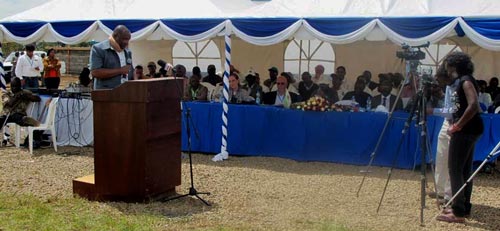Celebrations were in order at Kenya Agricultural Research Institute (KARI-Njoro) on 30 September 2011, when the International Testing Site for Resistance against the wheat stem rust, Ug99, was launched. More than 200 farmers, scientists, donors, government officials, and other stakeholders in the seed industry and wheat sector attended the event, which also doubled as a Farmers’ Open Day on ‘Recent advances towards addressing wheat stem rust’.
Presiding over the launch, Gideon Ndambuki, Kenya’s Assistant Minister for Agriculture, noted that the global redress could not have come at a better time; Ug99 seems to be running out of control and inflicting heavy losses in wheat production, worsening the food security situation in Kenya and worldwide.

From a simple stem rust screening nursery established by CIMMYT in collaboration with KARI in 2003, the KARI-Njoro site has been transformed, through the Borlaug Global Rust Initiative (BGRI) and the Durable Rust Resistance in Wheat (DRRW) project. Now it’s a world class screening facility, boasting 12ha of land dedicated to screening international germplasm for stem resistance; a water tank reservoir with a capacity of 1000 m3; three well-maintained boreholes; and an irrigation facility incorporating both drip and overhead systems.
Since opening as an international screening facility in 2005, the centre has screened over 200,000 accessions from more than 20 different countries and institutions. Over 20 Ug99-resistant varieties have been released worldwide and several more are anticipated. In Kenya, 11 accessions were entered in National Performance Trials with two varieties – Robin and Eagle10 – released early this year, thanks to an agreement with CIMMYT allowing KARI to release any variety with Ug99-resistance. These varieties have stem and yellow rust resistance, in addition to early maturation and high yields. KARI and the Kenya Seed Company are collaborating to multiply breeder seed, and expect to produce 10 tons of each variety to be made available to farmers by the end of the year.
Explaining why Kenya and Ethiopia were selected as ideal places for such a facility, Sridhar Bhavani, CIMMYT Wheat Pathologist/Breeder and eastern Africa Coordinator for DRRW project, noted that KARI-Njoro is a unique stem rust epidemiological region. It has good environmental conditions (rains/dew/temperature) allowing for year-round cultivation, and is a hot-spot for the evolution of new virulent forms of rust pathogens through migration, mutation, and recombination. “The initiative will be critical in curbing the spread of rust epidemics currently threatening the world’s wheat supply,” added Bhavani.
“I can’t say enough how much the global wheat community owes to Kenya,” said Ronnie Coffman, Director of the DRRW project and Vice-Chair of the BGRI. “Kenya and Ethiopia are shouldering the lion’s share of screening for a disease that threatens 70 percent of the world’s wheat varieties.” Reiterating the importance of the initiative, Ephraim A. Mukisira, KARI Director, stated “You have ignited a process that will impact the lives of the rural poor and the entire population of the global community. I am sure that because of this work, next year bread prices will be half the price of today.”